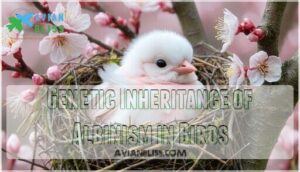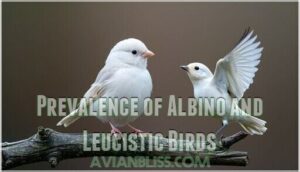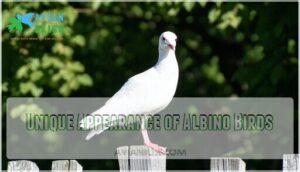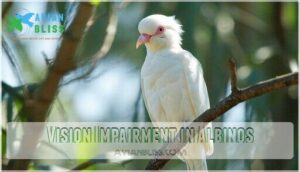This site is supported by our readers. We may earn a commission, at no cost to you, if you purchase through links.

You’ll find this condition affects roughly one in 30,000 birds, making true albinos incredibly rare compared to leucistic birds that retain some pigmentation.
These ghostly white creatures face serious survival challenges including impaired vision, increased predator vulnerability, and various physiological problems that make reaching adulthood extremely difficult.
Unlike their normally-colored counterparts, albino birds can’t blend into their surroundings, making them sitting ducks for predators.
Research from Cornell Lab of Ornithology shows these genetic mutations create a double-edged sword of beauty and hardship in nature’s most vulnerable birds, presenting a condition of beauty and hardship.
Table Of Contents
- Key Takeaways
- What is Albinism in Birds?
- Effects of Albinism on Birds’ Survival
- Genetic Inheritance of Albinism in Birds
- Characteristics of Albino Birds
- Prevalence of Albino and Leucistic Birds
- Unique Appearance of Albino Birds
- Contrasting Albino and Leucistic Birds
- Survey Results on Abnormal Plumage
- Albinism and Natural Selection
- Research and Support for Unusual Plumage Reports
- Frequently Asked Questions (FAQs)
- Can birds be albinos?
- Which is rarer, albino or leucistic?
- How to tell if a bird is albino?
- What is the rarest animal with albinism?
- How does albinism affect birds?
- How can people inherit albinism?
- What do albinistic birds look like?
- How many birds have Leucistic or albinism?
- Can birds have albinism?
- How rare are albino birds?
- Conclusion
Key Takeaways
- You’ll encounter true albino birds extremely rarely – only about 1 in 30,000 birds – making them far less common than leucistic birds that retain some pigmentation
- You can identify albino birds by their completely white plumage and distinctive pink or red eyes, while leucistic birds maintain normal dark eye color despite white feathers
- You’ll find that albino birds face severe survival challenges including impaired vision, increased predator vulnerability, and weakened feathers that make reaching adulthood extremely difficult
- You’re witnessing a genetic condition caused by recessive mutations that prevent melanin production, requiring both parents to carry the gene for offspring to express true albinism
What is Albinism in Birds?
When you spot a completely white bird with pink or red eyes, you’re likely seeing an albino bird with a rare genetic condition that blocks melanin production.
Spotting a pure white bird with red eyes? You’ve discovered nature’s rarest genetic lottery winner.
These birds face serious survival challenges because they can’t produce the dark pigment that normally protects their feathers and helps with vision.
Lack of Melanin
You’ll discover that bird albinism stems from a genetic mutation disrupting melanin production in feather structure.
This pigment deficiency occurs when genes controlling melanin function fail, creating pure white plumage instead of normal coloration.
Unlike dietary influence on some colors, this melanin deficiency is entirely genetic.
The mutation affects pigment production at the cellular level, leaving birds vulnerable to UV sensitivity.
This genetic condition differs from leucism, where birds produce melanin but can’t deposit it properly in their feathers, which is a distinct condition related to melanin production.
Impaired Vision
Bird albinism brings serious vision impairment that makes survival tough.
You’ll notice these birds struggle with three major visual challenges:
- Depth perception – Poor spatial awareness affects navigation and landing
- Light sensitivity – Photosensitivity causes discomfort in bright conditions
- Eye color changes – Pink or red eyes indicate damaged vision structures
These vision problems directly impact foraging success and predator evasion, making albino birds extremely vulnerable in the wild.
Rare Reach to Adulthood
Albino birds face tough odds in reaching adulthood, with survival rates plummeting due to multiple factors.
Most albino birds never survive their first year in the wild due to predation and physical challenges.
Their white plumage makes predator avoidance nearly impossible, while impaired vision reduces foraging success substantially.
Feather strength deteriorates without melanin, affecting flight performance.
Social acceptance becomes challenging when potential mates reject their unusual appearance.
Most bird albinism cases don’t survive past juvenile stages in unsuitable habitats.
Effects of Albinism on Birds’ Survival
While albino birds face numerous challenges in the wild, their survival depends on overcoming two major obstacles that put them at constant risk.
You’ll discover how their lack of pigmentation creates both predator vulnerability and serious health complications that make reaching adulthood extremely difficult.
Increased Vulnerability to Predators
You’ll notice that predator-vulnerability becomes a death sentence for albino birds in the wild.
Their camouflage absence creates a stark contrast against natural backgrounds, making them sitting ducks for hawks and other hunters.
Here’s how visibility increase impacts their survival:
- Bright white plumage eliminates natural camouflage protection
- Predators spot them easily during daylight foraging activities
- Habitat impact forces them into exposed, dangerous feeding areas
- Predator evasion becomes nearly impossible with their conspicuous appearance
- Survival rates drop dramatically due to increased predation pressure
True albinos are known for their complete pigment absence, making them stand out even more.
Physiological Challenges
Beyond survival threats, you’ll find that albino birds face serious internal health problems.
UV sensitivity creates constant sun damage risks, while feather weakness compromises flight performance. These birds struggle with thermoregulation and increased metabolic costs from working harder to maintain body temperature. A seed-only diet can exacerbate these issues, potentially leading to nutritional deficiencies.
| Challenge | Impact | Survival Effect |
|---|---|---|
| Bird vision problems | Poor depth perception, eye movement issues | Reduced foraging success |
| Sun sensitivity | Skin damage, overheating | Limits daytime activity |
| Neurological impacts | Coordination difficulties | Affects escape responses |
| Behavioral challenges | Social rejection, mating difficulties | Lower reproductive success |
These physiological challenges explain why predation rates stay high for albino birds.
Genetic Inheritance of Albinism in Birds
Understanding genetic inheritance reveals why bird albinism remains so remarkably rare in nature.
This genetic mutation disrupts melanin production through specific hereditary pathways that you’ll find fascinating.
The inheritance pattern follows three critical mechanisms:
- Recessive Genes: Both parents must carry the mutated gene for offspring to express albinism, creating a 25% probability when both are carriers.
- Tyrosinase Mutation: The TYR gene mutation prevents tyrosinase enzyme production, completely blocking melanin synthesis and causing white pigmentation.
- Gene Complexity: Multiple genes influence the condition, including SLC45A2, making actual occurrences rarer than simple Mendelian genetics predict.
Sex-linked albinism can produce partial effects, while inbreeding effects increase occurrence rates in isolated populations.
This genetic inheritance pattern explains why you’re more likely to spot leucistic birds than true albinos in the wild, as the genetic requirements create natural barriers to widespread albinism expression.
Characteristics of Albino Birds
You’ll recognize an albino bird immediately by its completely white feathers and distinctive pink or red eyes.
These striking physical features result from the total absence of melanin, the pigment that normally gives birds their natural colors and dark eye appearance.
White Plumage
When you spot a bird with pure white plumage, you’re witnessing nature’s rarest color mutation.
This complete absence of melanin creates feathers that lack any pigmentation whatsoever, unlike leucism in birds where some color remains.
The white plumage results from faulty bird pigmentation systems that can’t produce melanin.
| Plumage Aspect | Albino Bird Characteristics |
|---|---|
| Feather Structure | Weakened due to melanin absence |
| Plumage Coloration | Pure white throughout |
| Camouflage Absence | Highly visible to predators |
| UV Protection | None – increased sun damage |
| Thermal Regulation | Poor heat absorption |
These bird color mutations create striking visual contrasts in natural settings.
However, the beautiful white plumage comes with serious survival costs.
Without melanin strengthening their feathers, albino birds face structural weakness and reduced flight efficiency.
The lack of camouflage makes them sitting ducks for predators in most environments.
Albino birds often require specialized captive care to address their unique needs.
Red or Pink Eyes
While white plumage catches your attention first, the red or pink eyes of albino birds tell the real story.
These distinctive eyes result from blood vessel visibility through transparent tissues, a direct consequence of iris pigment absence.
Without melanin’s protective shield, you’re looking at exposed capillaries beneath the surface.
Eye development in albino birds creates three major challenges:
- Light sensitivity makes bright environments painful and potentially damaging to their vision
- Genetic correlation between albinism and poor eyesight reduces their hunting and navigation abilities
- Bird eye color changes affect depth perception and focus, making survival tasks more difficult
The pink eyes you observe aren’t just unusual—they’re a window into the bird’s struggles.
Melanin deficiency doesn’t just affect pigmentation; it fundamentally alters how these birds experience their world.
Bird albinism creates eyes that function poorly in natural lighting conditions, explaining why so few albino birds survive to adulthood in the wild.
Prevalence of Albino and Leucistic Birds
You’ll find that true albino birds are remarkably rare in nature, with estimates suggesting they occur in less than one percent of all bird populations.
When you do spot an unusual white bird, it’s actually about ten times more likely to be leucistic rather than truly albino.
Rarity of Albino Birds
Encountering albino birds in the wild is like winning the lottery twice.
These melanin-deficient marvels appear in roughly 1 in 30,000 birds, making them extraordinarily rare sightings.
Mutation rates for bird albinism remain consistently low across population sizes, though environmental factors and geographic distribution can influence local occurrences.
Reporting bias often inflates perceived numbers since birdwatchers enthusiastically document unusual pigmentation anomalies.
True albino birds represent nature’s rarest rare bird sightings, far more elusive than their leucistic cousins.
These birds often lack robustness due to genetic pigment absence.
Ratio of Leucistic to Albino Birds
How dramatically do leucistic birds outnumber their albinism counterparts? The numbers tell a striking story about bird genetics and pigmentation disorders.
Survey data from the British Trust for Ornithology reveals that leucism frequency far exceeds albinism rarity in wild populations. Out of 100 birds displaying abnormal plumage, you’ll find 82 leucistic individuals compared to only 3 true albino birds.
This creates hybrid ratios of approximately 27:1, making leucistic birds nearly thirty times more common than albinos. Environmental factors and regional variations influence these patterns.
Urban areas often show higher leucism rates, possibly due to reduced predation pressure or exposure to mutagens. Genetic mutations affecting pigmentation occur differently – leucism results from partial pigment cell absence, while albinism stems from complete melanin production failure.
Key differences you should know:
- Leucistic birds retain normal eye colors; albino birds have pink/red eyes
- Environmental contaminants may increase leucism frequency
- Both conditions affect roughly 1 in 30,000 birds overall
- Species like blackbirds show higher rates of both conditions
- Detection bias favors leucistic bird reporting over albino sightings
Unique Appearance of Albino Birds
Observing albino birds in the wild feels like discovering nature’s rarest gems.
You’ll immediately notice their pure white plumage that contrasts dramatically with their surroundings.
This complete absence of feather pigmentation results from genetic mutations affecting melanin production throughout their bodies.
When you spot these white birds, their eye color becomes the defining feature.
You’ll see pink or red irises caused by visible blood vessels beneath transparent, unpigmented tissue.
Their bare parts – including beaks, legs, and skin – appear pale pink or flesh-colored, creating identification challenges since normal field marks disappear entirely.
These plumage variations make abnormal coloration instantly recognizable.
Unlike their colorful counterparts, albino birds display uniform whiteness across every feather.
This striking appearance, while beautiful, signals the underlying genetic mutations that affect their entire physiology.
You’re witnessing nature’s genetic lottery – a condition so rare that spotting one becomes a memorable birding experience.
Contrasting Albino and Leucistic Birds
When you’re trying to identify a white bird, you’ll need to look closely at their eyes to tell the difference between albino and leucistic birds.
Albino birds have pink or red eyes due to visible blood vessels, while leucistic birds keep their normal dark eye color even with white feathers.
Vision Impairment in Albinos
Beyond their white plumage, albino birds face serious vision problems that leucistic birds don’t experience.
You’ll notice their red or pink eye color isn’t just cosmetic – it signals deeper issues with their bird eyesight. The absence of pigment cells in their eyes creates multiple challenges that make survival incredibly difficult.
Photophobia affects these birds severely, as they can’t tolerate bright sunlight that doesn’t bother normal birds. Their light sensitivity forces them to seek shade constantly, limiting feeding opportunities.
Depth perception becomes compromised when melanin doesn’t develop properly in eye structures, making it harder to judge distances accurately.
Spatial awareness suffers dramatically in albino birds because their eyes often don’t align correctly or move uncontrollably. This impairment affects prey detection for predatory species and makes escape from danger nearly impossible.
While leucistic birds maintain normal vision with dark eyes, albinos struggle with basic visual tasks that healthy birds take for granted. They’re also more susceptible to corneal ulcers due to increased light exposure.
Differences in Plumage
While albino birds face vision problems, their plumage differences from leucistic birds reveal fascinating genetic mutations.
You’ll notice these key distinctions in feather pigmentation:
- Complete vs. Partial Loss: Albino birds show total melanin distribution failure, creating pure white plumage.
- Pigmentation Disorders: Bird pigmentation disorders affect different body parts.
- Survival Impact: These genetic mutations influence survival differently.
Leucistic birds retain some pigmentation, producing varied color aberrations and patchy patterns.
Albinism impacts all feathers uniformly, while leucism creates selective plumage variations in specific areas.
Leucistic birds blend better with environments than completely white albino birds.
Survey Results on Abnormal Plumage
Scientists have gathered valuable data on abnormal bird plumage through organized research efforts.
You’ll find that major ornithological institutions have conducted surveys to document the frequency and patterns of these unusual genetic conditions in wild bird populations.
Cornell Lab of Ornithology’s Findings
When you explore the Cornell Lab of Ornithology’s FeederWatch Program findings, you’ll discover remarkable data on bird pigmentation disorders.
Their plumage database reveals approximately 236 birds with abnormal plumage annually from 5.5 million reports—showcasing true rarity.
Citizen science contributions through reporting plumage anomalies helped researchers conduct thorough data analysis.
Research contributions identified that blackbirds, house sparrows, jackdaws, and carrion crows show higher frequencies of leucism and other pigment disorders.
These avian genetics studies demonstrate how albino birds represent just a fraction of documented cases, with most submissions involving partial pigmentation loss rather than complete albinism.
You can find related merchandise at the Cornell bird survey.
British Trust for Ornithology’s Records
How thorough is the British Trust for Ornithology’s BTO Data Analysis on unusual bird coloration? Their extensive survey documented 3,000 records of bird abnormalities, revealing striking patterns in bird variations.
The Historical Albinism Trends show leucism dominates at 82% of cases, while true albino birds represent just 3% of abnormal plumage reports.
Regional Albinism Rates vary substantially across species and locations. Blackbirds, house sparrows, jackdaws, and carrion crows displayed higher frequencies of unusual coloration.
The survey’s Data Collection Methods rely on verified field observations, though Reporting Biases toward common, visible species likely influence results. This bird leucism research provides vital insights into geographic distribution patterns and species susceptibility, helping scientists understand why certain populations develop more pigmentation disorders than others.
Researchers can find resources for detailed data exploration to further analyze these trends.
Albinism and Natural Selection
When you observe albino birds in nature, you’ll notice they face severe disadvantages that natural selection works against.
Their bright white plumage and impaired vision make them easy targets for predators, while their weakened feathers and social difficulties reduce their chances of surviving long enough to reproduce, which is a significant disadvantage.
Disadvantages in The Wild
You’ll quickly discover that albino birds face overwhelming challenges in natural habitats.
Their stark white plumage makes them sitting ducks for predators, while vision problems hamper basic survival skills like finding food and avoiding danger.
- Predator vulnerability: White feathers eliminate camouflage, making birds easy targets against natural backgrounds
- Mating challenges: Unusual appearance often leads to rejection during courtship, reducing reproductive success substantially
- Foraging success: Poor vision and feather strength issues limit effective hunting and environmental adaptation capabilities
Impact on Survival
You’ll find that survival statistics paint a stark picture for albino birds.
Their conspicuous white plumage creates severe predator vulnerability, making camouflage issues nearly impossible to overcome.
Environmental stressors compound these problems – reduced feather strength affects flight performance while impaired vision hampers foraging success.
Mate selection becomes challenging since potential partners often reject their unusual appearance.
Bird survival rates drop dramatically, with fewer than 25% of albino birds reaching adulthood compared to their normally pigmented counterparts.
These mating challenges and predator avoidance difficulties create an uphill battle against nature’s selective pressures, making it hard for albino birds to overcome the issues of predator vulnerability and reach adulthood.
Research and Support for Unusual Plumage Reports
While albino birds struggle with survival challenges, you can help scientists understand these remarkable creatures through citizen science.
Data collection programs like Cornell Lab’s FeederWatch and BTO’s Abnormal Plumage Survey rely on your observations. These initiatives document plumage variations, leucism, and true albinism across species.
Your reports follow specific reporting protocols – noting plumage details, eye color, and behavior. Understanding specific reporting products can further enhance data accuracy.
With melanin deficiencies affecting survival, conservation efforts benefit from tracking these genetic anomalies. Even spotting partial albinism at your feeder contributes valuable scientific data about albino birds and their distribution patterns.
Frequently Asked Questions (FAQs)
Can birds be albinos?
Yes, you can spot albino birds! They’re rare, they’re striking, they’re unforgettable.
These genetic mutations create pure white plumage with pink eyes, making survival challenging due to increased predation risk and vision problems.
Which is rarer, albino or leucistic?
Albinism occurs far less frequently than leucism in birds.
You’ll spot leucistic birds more often since albinism requires inheriting recessive genes from both parents, making it exceptionally uncommon in wild populations.
How to tell if a bird is albino?
Like a detective examining clues at a crime scene, you’ll spot an albino bird by its completely white feathers and telltale pink or red eyes.
Revealing the absence of melanin pigment throughout is a key characteristic, and this is evident in the completely white feathers.
What is the rarest animal with albinism?
Migaloo the humpback whale stands alone as the world’s only known albino whale, making him quite possibly the rarest albino animal on earth.
You’d have better odds winning the lottery than spotting this ghostly giant.
How does albinism affect birds?
You’ll notice albino birds struggle substantially in the wild.
Their pure white feathers make them easy prey, while their pink eyes cause vision problems, making survival and finding mates extremely difficult.
How can people inherit albinism?
Imagine inheriting traits like puzzle pieces passed down through generations. You inherit albinism when both parents carry recessive genes, creating a 25% chance if they’re both carriers.
What do albinistic birds look like?
You’ll spot albinistic birds by their pure white plumage and distinctive pink or red eyes. Their beaks, legs, and skin appear pale pink or flesh-colored due to complete melanin absence.
How many birds have Leucistic or albinism?
You’ll find leucistic birds are far more common, appearing in roughly 82% of abnormal plumage cases, while true albinism affects only about 3% of these rare occurrences.
Can birds have albinism?
A snowy owl with pure white feathers and pink eyes catches your attention at a bird feeder.
Yes, birds can develop albinism, a rare genetic condition causing complete melanin loss, resulting in white plumage and distinctive pink eyes.
How rare are albino birds?
True albino birds are extremely rare – you’ll encounter them maybe once in 30,000 birds. Most white birds you’ll spot are actually leucistic, not albino, since albinos rarely survive to adulthood.
Conclusion
Understanding bird albinism reveals nature’s most extraordinary genetic lottery – where stunning beauty meets devastating consequences.
You’ve discovered that these one-in-30,000 rarities face impossible odds, battling impaired vision and predator vulnerability that make survival nearly miraculous.
While leucistic birds retain some advantages, true albino birds represent nature’s most fragile masterpieces, with a ghostly white appearance that captivates observers but condemns them to shortened lives.
Supporting research on abnormal plumage helps scientists better understand these remarkable creatures and their challenging existence in the wild, which is a remarkable aspect of their study.
- https://avianreport.com/how-rare-leucistic-albino-birds/
- https://scholarworks.uark.edu/cgi/viewcontent.cgi?article=3041&context=jaas
- http://cricket.biol.sc.edu/chernobyl/papers/Moller-et-al-MR17122012-in-press-sm.pdf.bak
- https://www.allaboutbirds.org/news/what-can-cause-birds-to-show-weird-color-variations-such-as-being-all-or-partly-white-or-unusually-dark/
- https://pmc.ncbi.nlm.nih.gov/articles/PMC1800597/














